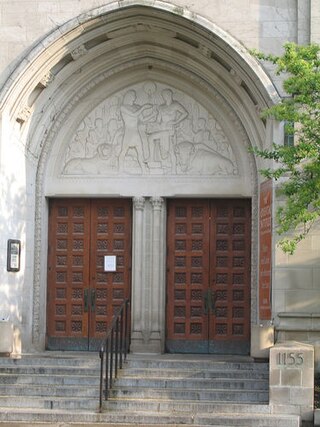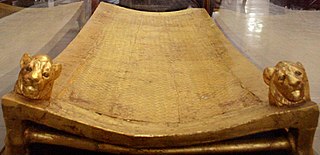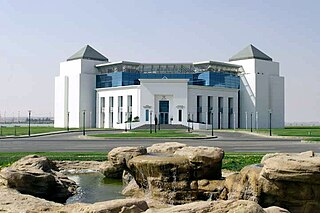
Egyptology is the scientific study of ancient Egypt. The topics studied include ancient Egyptian history, language, literature, religion, architecture and art from the 5th millennium BC until the end of its native religious practices in the 4th century AD.

The Institute for the Study of Ancient Cultures, West Asia & North Africa, established in 1919, is the University of Chicago's interdisciplinary research center for ancient Near Eastern studies and archaeology museum. It was founded for the university by Egyptology and ancient history professor James Henry Breasted with funds donated by John D. Rockefeller Jr. It conducts research on ancient civilizations throughout the Near East, including at its facility, Chicago House, in Luxor, Egypt. The institute also publicly exhibits an extensive collection of artifacts related to ancient civilizations and archaeological discoveries at its on-campus building in Hyde Park, Chicago. According to anthropologist William Parkinson of the Field Museum, the ISAC's highly focused "near Eastern, or southwest Asian and Egyptian" collection is one of the finest in the world.

The J. Paul Getty Trust is the world's wealthiest art institution, with an estimated endowment of US$7.7 billion in 2020. Based in Los Angeles, California, it operates the J. Paul Getty Museum, which has two locations—the Getty Center in the Brentwood neighborhood of Los Angeles and the Getty Villa in the Pacific Palisades neighborhood of Los Angeles. Its other programs are the Getty Foundation, the Getty Research Institute, and the Getty Conservation Institute.

Cultural heritage is the heritage of tangible and intangible heritage assets of a group or society that is inherited from past generations. Not all heritages of past generations are "heritage"; rather, heritage is a product of selection by society.

Salima Ikram is a Pakistani professor of Egyptology at the American University in Cairo, a participant in many Egyptian archaeological projects, the author of several books on Egyptian archaeology, a contributor to various magazines and a guest on pertinent television programs.

Repatriation is the return of the cultural property, often referring to ancient or looted art, to their country of origin or former owners.

David Bourke O'Connor was an Australian-American Egyptologist who primarily worked in the fields of Ancient Egypt and Nubia.

The Staatliche Museen zu Berlin are a group of institutions in Berlin, Germany, comprising seventeen museums in five clusters; several research institutes; libraries; and supporting facilities. They are overseen by the Prussian Cultural Heritage Foundation and funded by the German federal government in collaboration with Germany's federal states. The central complex on Museum Island was added to the UNESCO list of World Heritage Sites in 1999. By 2007, the Staatliche Museen zu Berlin had grown into the largest complex of museums in Europe. The museum was originally founded by King Friedrich Wilhelm III of Prussia in 1823 as the Königliche Museen.

Exhibitions of artifacts from the tomb of Tutankhamun have been held at museums in several countries, notably the United Kingdom, Soviet Union, United States, Canada, Japan, and France.
The office of American Schools and Hospitals Abroad (ASHA) is an organizational unit within the Bureau of Democracy, Conflict, and Humanitarian Assistance (DCHA) at the United States Agency for International Development (USAID). ASHA is charged by the President of the United States with administering a worldwide assistance program with the objective of promoting American ideas and values abroad.
Dr. Nicholas Byram Millet was an Egyptologist affiliated with the Royal Ontario Museum and the University of Toronto. An archaeologist, art historian, linguist, museum curator, administrator, and celebrated teacher, Millet was able to make great strides in the daunting task of translating the lost language of the ancient Sudan, Meroitic. His careful study of the unusual script led to the decipherment of a number of Meroitic words, phrases, and verb formations, and helped shed some light on the social and political constructs of this mysterious civilization. No one else has approached his level of contribution to knowledge of this important ancient African empire. Millet's final word on the Meroitic language was published posthumously in "The Meroitic Inscriptions from Gebel Adda", The Journal of the Society for the Study of Egyptian Antiquities in 2005.
Lyla Pinch Brock is a Canadian Egyptologist, specializing in epigraphy. She lives in Saissac, France.

The Center for Documentation of Cultural and Natural Heritage (CULTNAT) of the Cultural Outreach Sector of the Bibliotheca Alexandrina plays an important and unique role in documenting Egypt's cultural heritage in its tangible and intangible aspects, besides Egypt's natural heritage from protectorates and wildlife. The center has contributed, for nearly two decades, to documenting and disseminating information related to heritage through the implementation of many projects for digital documentation of Egyptian heritage using the latest information technology technologies in cooperation with specialized local and international bodies and the center is keen to increase awareness of cultural and natural heritage and the Egyptian identity by benefiting from various media channels. CULTNAT also builds the capacities of workers in the field of documenting and preserving civilizational and natural heritage. It was established in 2000, and is located in Smart Village.
Willemina Zwanida "Willeke" Wendrich is a Dutch-American Egyptologist and archaeologist. She is Professor and Joan Silsbee Chair of African Cultural Archaeology in the Near Eastern Language & Cultures Department at the University of California, Los Angeles. Since 2016 she is the Director of the Cotsen Institute of Archaeology.
The Archives at the American Academy in Rome (AAR) are digitized archaeological and photographic collections assisting in the preservation and conservation of the cultural heritage of Rome.
Jehane Noureldin Ragai is an Emeritus Professor of Chemistry at the American University in Cairo (AUC). She is the author of the two editions of The Scientist and the Forger. The first edition, published in 2015 by Imperial College Press, was translated into Korean. The second edition, published in 2018 by World Scientific Publishing, was translated into Chinese. Her recent Textbook Technical Art History, published in 2021 by World Scientific Publishing, which she co-authored with Tamer Shoeib has won the "Most Promising New Textbook Award " by the Textbook and Academic Authors Association in the US.
Myriam Seco Álvarez is a Spanish archaeologist and Egyptologist. A distinguished authority in those fields, the author of several reference books, and responsible for excavations in the Middle East and Egypt, she has launched and directed important archaeological projects, including the excavation and restoration of the mortuary temple of Pharaoh Thutmose III. The so-called "Spanish Indiana Jones", she has had a prolific professional career and a broad international presence.

The coffin of Nedjemankh is a gilded ancient Egyptian coffin from the late Ptolemaic Period. It once encased the mummy of Nedjemankh, a priest of the ram-god Heryshaf. The coffin was purchased by the New York City Metropolitan Museum of Art in July 2017 to be the centerpiece of an exhibition entitled "Nedjemankh and His Gilded Coffin." The Metropolitan Museum of Art repatriated Nedjemankh and his coffin to Egypt in 2019, before the scheduled closure of the exhibition.
Mervat Seif el-Din, Arabic: ميرفت سيف الدين is a classical archaeologist from Egypt, who was Director of the Graeco-Roman Museum of Alexandria from 2004 to 2010. A specialist in the archaeology of Alexandria, el-Din is an expert on faience and funerary painting in particular.

The International Campaign to Save the Monuments of Nubia was the relocation of 22 monuments in Lower Nubia, in Southern Egypt and northern Sudan, between 1960 and 1980. The success of the project, in particular the creation of a coalition of 50 countries behind the project, led to the creation of the World Heritage Convention in 1972, and thus the system of World Heritage Sites.










